Climate change and its impact on Central Asia
- Speech delivered at the World Journalist Conference on 20 April 2021
By Kuban Taabaldiev
Director General, Kabar News Agency
Kyrgyz Republic
BISHBEK: The region of Central Asia is facing increasingly more irreversible processes caused by climate change. Many know of the tragedy in the region caused by the drying up of such a large lake as the Aral Sea, which was located in the center of the region and influenced the balancing of the regional climate. The lake has dried up during two generations of people and now less than a quarter of the reservoir remains. Before that, it was engaged in fish farming, as well as shipping, with existing corresponding infrastructure.
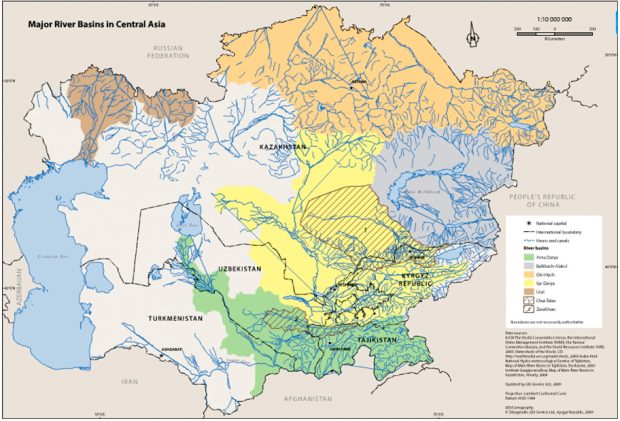
Basins of the main rivers of Central Asia (Source: www.caatlas.org)
The changes caused by the consequences of the ecological catastrophe are very noticeable in the climate in the region. A dust storm rises from the bottom of the dried-up lake, which spreads almost throughout the entire region. Countries with large reserves of glaciers, like Tajikistan and Kyrgyzstan, are especially affected by this because dust falling on the glaciers from the Aral Sea accelerates the melting of the ice.
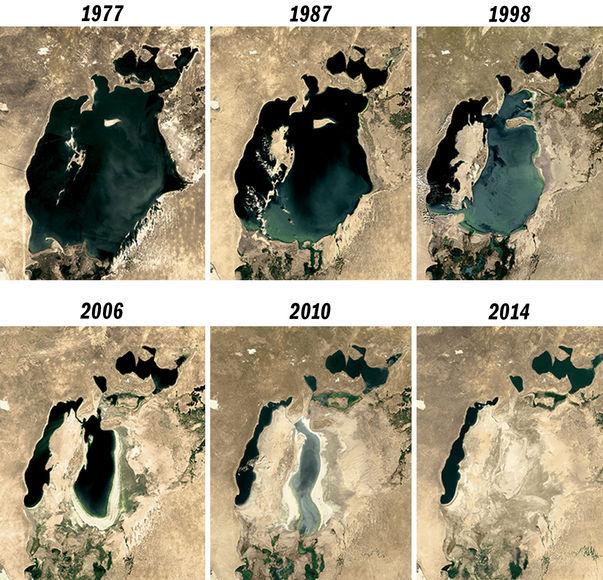
Tragedy of Aral sea (Source: www. novotours.uz)
The mountains of these countries accumulate almost 90% of the region’s glaciers, which have remained unchanged for centuries. The water reserves in the two countries are accumulated by glaciers melting in summer formed all account regional reserves. In other words, the glaciers of these two countries constitute the main source of drinking and irrigation water. The water flows of the Amu Darya River originate in the mountains of Tajikistan and run through the territory of four neighboring countries, the Naryn River, formed in the mountains of Kyrgyzstan, becomes the Syr Darya River. About 40 years ago, these rivers flowed into Lake Aral and kept its level in balance.
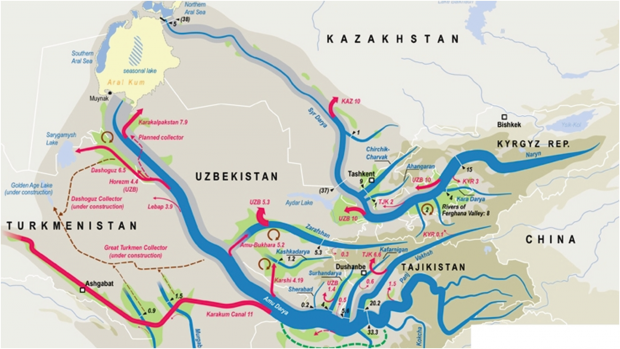
Amu Darya and Syr Darya in Central Asia (Source: syr-darya.org/riversmaps)
Due to the melting of glaciers, the total area of glaciers in the two countries has decreased by 30%. Because of this, the inflow of water from the mountains into the main rivers of the two countries, the Amu Darya and the Syr Darya have significantly decreased. Meanwhile, these two rivers provide moisture during the growing season, and also almost 70% of the electricity for their countries is generated by hydroelectric power plants on these rivers To reach the full potential of these hydroelectric power stations, water is accumulated in reservoirs in the summer and is used to generate electricity in the winter.
The decrease in water inflow in the summer is a matter of concern for the authorities of the two countries – if 15-20 years ago Kyrgyzstan and Tajikistan were considered as exporting countries of electricity, now, due to a lack of water in the winter, both Kyrgyzstan and Tajikistan are forced to buy electricity from their neighbors. This is only one of many consequences of climate change in the region.
The second problem is the lack of drinking water in the regions of Central Asia. With a huge hydropower potential, almost a third of the population of the entire region suffers from a lack of clean drinking water. Gradually, with the financial support of international organizations, about a third of the population of Kyrgyzstan and Tajikistan has gained access to drinking water extracted from the ground through drilling.
Meanwhile, the situation with climate change on a global scale is causing concern in Central Asia.
According to experts, the increase in air temperature in Central Asia for the period of 2030-2050 will reach an additional +1°С.
Such warming will not only lead to a decrease in the volume of glaciers, but also to a large amount of evaporation of all water bodies in the region in the near future.
According to scientists, an increase in air temperature by 1° leads to an increase in the intensity of evaporation of water from the surface by 16%.
In this case, even taking into account the preservation of the norm of precipitation, the water content of the rivers in the region will decrease.
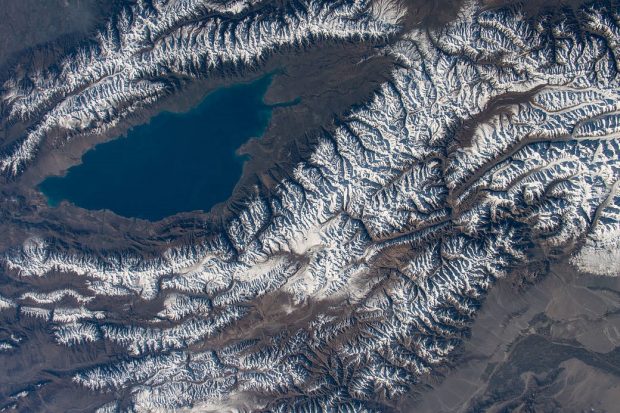
Issyk-Kul Lake from Space
Source: commons.wikimedia.org
Famous in Central Asia Lake Issyk-Kul is becoming an increasingly attractive destination for tourists. This lake is surrounded by high mountains, up to 5000 meters high. The peaks of these mountains have always remained covered with ice, even in the hottest summer months. However, in the past 10 years, scientists are noticing more frequently that the mountains around the Lake appear to be without glittering glaciers. They note that for the Issyk-Kul basin: with a 1° increase in temperature, the ice area on the southern mountain ranges will decrease by 19%, and on the northern ridge – by 5%.
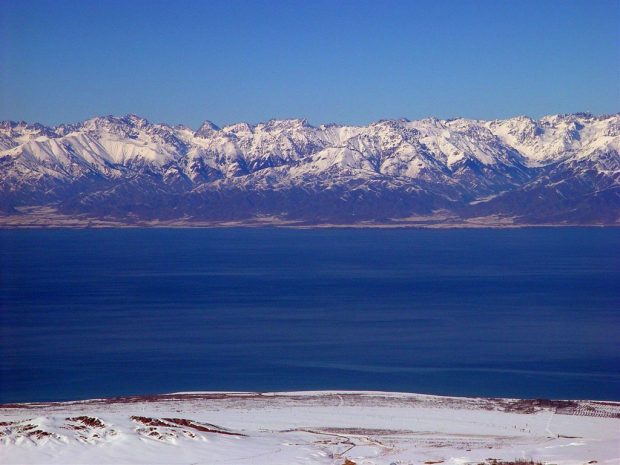
Issyk-Kul Lake in Winter (Source: funart.pro)
And if the temperature increases by 2° – the size of the glaciers on the southern slope of the mountains will decrease by 76% and on the northern slope by 32%.
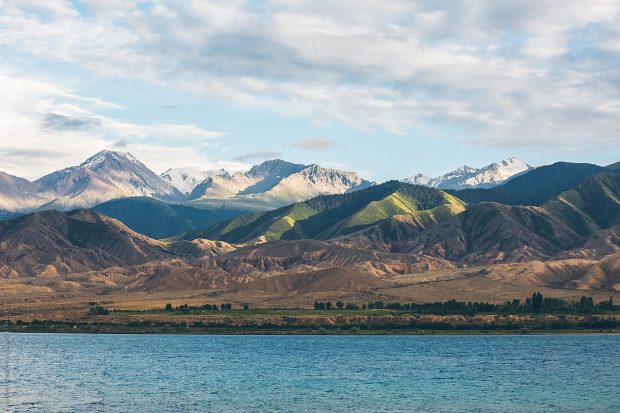
Issyk-Kul in Summer (Source: boredpanda.com)
In other words, scientists fear that overheating in the valley may lead to an imbalance in water flows, more water will drain in the south of the lake and lead to a decrease in glaciers, and vice versa – in the north of the lake, rivers will become shallower, the volume of water will decrease faster. And this is steadily leading to natural disasters.
As a result of climate change, there is an increase in mudflows, landslides, and avalanches. Only in Kyrgyzstan alone, there are more than 5,000 different hazardous areas prone to landslides.
The danger of landslides in mountainous regions of the two neighboring states will accelerate due to climate change. Moreover, more than 60% of the population lives on the mountain slopes. Over the past 30 years, both Tajikistan and Kyrgyzstan have already suffered from massive landslides, in which people died, and some settlements simply disappeared under the rubble.
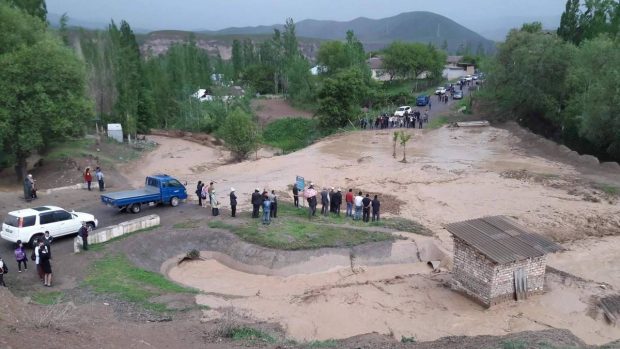
Landslide near a village in the foothills (Source: unescap.org)
At present, in Central Asia, in addition to the danger of earthquakes, the danger of mudflows from the mountains is growing more and more for the three largest cities of the region: a mudflow from the Chimbulak mountains threatens Almaty in Kazakhstan; the mudflow from Ala-Archa gorge has descended upon Bishkek in Kyrgyzstan many times, and in the city of Dushanbe in Tajikistan for several decades there is a danger of collapse of Lake Sarez.
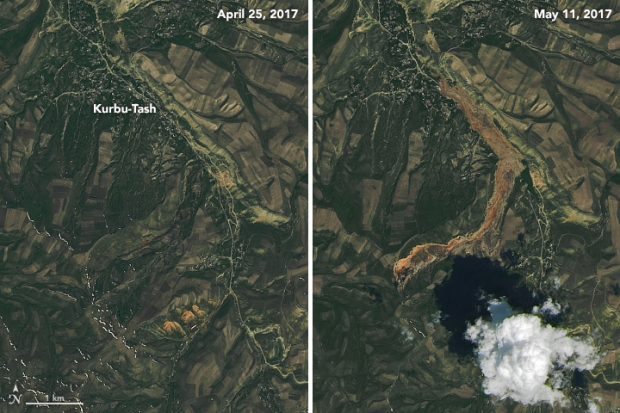
Mountain before and after landslide (Source: unescap.org)
In general, more than 10 million people live in the dangerous mudflow zones of Central Asia, and climate change, causing the accelerated melting of glaciers, leads to increased risks of mudflows down to the plains, where the bulk of the population lives.
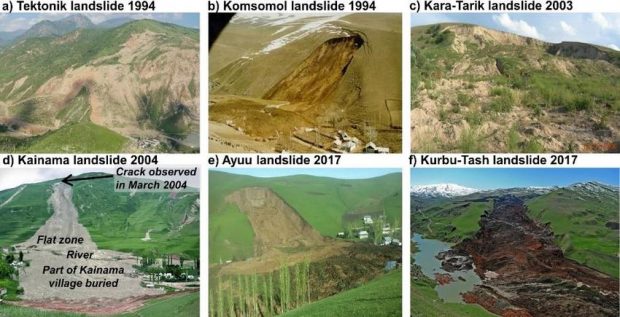
Different types of landslide (Source: researchgate.net)
Rapid climate change around the world leads to the fact that the measures taken are lagging behind and the danger is growing. In the past two years, the situation has worsened due to the downturn in the economies of the region’s countries due to the coronavirus pandemic.
Media in the region regularly cover main issues related to the ecological situation. However, their influence on the situation, to the mentality of society is not as well as it is in European countries and, as a good example, in South Korea.
Therefore, the world community and international organizations should be notified of possible natural phenomena caused by climate change for a region with a total population of more than 80 million people and huge historical baggage.










































